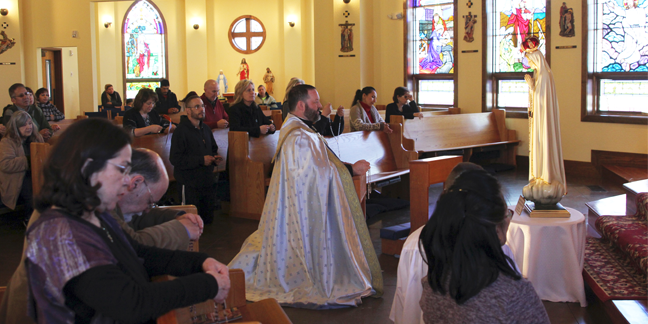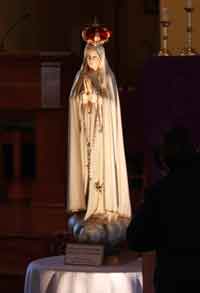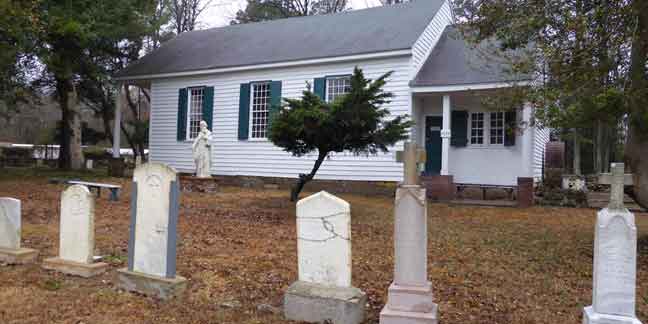 CHARLOTTE — A soft dusting of snow and Marian blue skies announced the arrival of the International Pilgrim Virgin Statue of Fatima to Waynesville on Sunday, the first of three stops in the Diocese of Charlotte as part of the statue’s U.S. Tour for Peace. The national tour commemorates the 100th anniversary of the apparitions of Our Lady of Fatima to three shepherd children in Portugal.
CHARLOTTE — A soft dusting of snow and Marian blue skies announced the arrival of the International Pilgrim Virgin Statue of Fatima to Waynesville on Sunday, the first of three stops in the Diocese of Charlotte as part of the statue’s U.S. Tour for Peace. The national tour commemorates the 100th anniversary of the apparitions of Our Lady of Fatima to three shepherd children in Portugal.
The national tour commemorates the 100th anniversary of the apparitions of Our Lady of Fatima to three shepherd children in Portugal.
Three parishes – St. John the Evangelist Church in Waynesville, St. Patrick Cathedral in Charlotte and Our Lady of Mercy Church in Winston-Salem – hosted the pilgrim statue during its tour March 12-14 through western North Carolina.
A PRAYER FOR UNITY
Bringing the world-famous pilgrim statue to St. John the Evangelist Church was the answer to more than a year of prayer by many parishioners, even though they “didn’t think it was a possibility” it would come “to little old Waynesville,” said Father Christopher Riehl, administrator.
A couple hundred people were on hand Sunday for Mass, rosaries recited in English and Spanish, and a procession around the Waynesville church grounds.
“It’s an honor – more than I expected,” said Fred Waring, who helped carry the statue in the procession.
For St. Joseph Sister Mary Ruth Masters, who runs the private day school St. Joseph Academy in Maggie Valley, the pilgrim statue’s visit to her parish was the answer to her prayers and the prayers of a lot of other people.
St. John’s, a small mountain parish community of about 300 registered families, has been rocked by division since a group of parishioners left in protest about a year and a half ago.
“There’s been a lot going on in this parish that needs to be remedied,” Sister Mary Ruth said.
About the same time as the divisiveness was erupting at St. John’s, she read about the pilgrim statue’s U.S. tour and thought, “Why not here?” She enlisted the help of fellow parishioners and Father Riehl, and soon many others joined in the prayer effort.
“I really would like to see unity in this parish and support for Father, and to overcome any difficulties people have,” Sister Mary Ruth said. “Our Lady is the one who’s going to lead us into heaven.”
The message of Our Lady of Fatima is just as relevant today as it was in 1917, Father Riehl noted. He hoped the pilgrim statue’s presence would “start a spark,” motivating people to come back together as well as encouraging everyone to deepen their prayer life.
The tangible presence of Our Lady’s pilgrim statue this week, he said, was a reminder that the Waynesville parish is part of the Church worldwide – just like seeing the pope in person brings a greater understanding than just seeing a photo of him.
“You start to forget the things that divide us and start to think about the things that connect us. These moments help remind people of that,” he said.
Devotion to Mary is also a “Catholic hallmark” that bridges cultures, languages and races, he noted. “She becomes a source of unity across the entire Church.”
Through the presence of the pilgrim statue of Our Lady of Fatima, he hopes people will learn more about Fatima, grow closer to Jesus through His mother Mary, and seek the sacraments more frequently – particularly the Eucharist and reconciliation.
“We’ve been growing in devotion,” Father Riehl said, especially with Mass attendance, confessions and catechetical programs, “but I want to keep that going – especially among the youth.”
‘OUR LADY HAS COME’
From Waynesville the statue traveled Sunday evening to Charlotte, and approximately 300 faithful from across the Queen City filled St. Patrick Cathedral to take part in a candlelight procession and prayer service, followed by overnight veneration that continued through Monday.
“Our Lady has come, and she is here with us,” Bishop Peter J. Jugis said. “It is a privilege for us to spend time with her during these days, these hours, and bring to her our special petitions.”
Bishop Jugis prayed that through Mary’s intercession, people’s hearts may be purified and made pleasing to God – especially during this year which the diocese is devoting to her Immaculate Heart.
“What a beautiful sign of God’s providence that she should be coming here, during this year celebrating the Year of the Immaculate Heart,” he said.
Among the hundreds of people in attendance at the procession and prayer service was St. Matthew parishioner Cristy Calicdan. “I was just in Fatima last month on a pilgrimage. I have a devotion to Our Lady of Fatima. We brought our petitions to Fatima and our friends’ petitions.”
Ana Jones, a parishioner of St. Patrick Cathedral, has a special connection to Our Lady of Fatima. She was at the procession with her family. “We grew up in Portugal, so this is very special. Last time I was in Fatima was 2006. She has interceded many times for our family.”
Father Patrick Winslow, pastor of St. Thomas Aquinas Church in Charlotte, gave the homily during the vespers service before the procession, urging people to take to heart Our Lady of Fatima’s message of conversion, penance and prayer.
“The Virgin Mother, who became our mother from the cross, is speaking to a whole generation, to each of us,” Father Winslow said.
“She’s giving us not high and lofty thoughts,” he said, but practical advice: “Pray, fast, do penance, and above all, pray the rosary.”
ENCOUNTERING OUR LADY
The statue also went to Our Lady of Mercy Church in Winston-Salem for veneration March 14. The parish has a small chapel downtown dedicated to Our Lady of Fatima, but because of limited access there, the statue was enthroned at the main church. Parishioners and students from Our Lady of Mercy School took part in venerating the statue, praying the rosary, singing Marian hymns, and processing with the statue from the church along Link Road to the school soccer field and back.
“I’m hoping that having Our Lady of Fatima here will encourage more of our parishioners to learn about Fatima and perhaps develop a devotion to her,” said Conventual Franciscan Father Carl Zdancewicz, pastor. “We have a very diverse population at Mercy – Hispanic, Vietnamese and a group of families from the Burmese mountains. For some of them, this will be their first encounter with Our Lady of Fatima.”
“I went to Fatima about 10 years ago,” he added, “and saw the devotion there…I’m hoping to encourage devotion to Our Lady of Fatima and her message of peace.”
The statue’s visit concluded with a bilingual service of hymns, a homily by Conventual Franciscan Father Joseph Angelini, parochial vicar, and vespers.
Larry Maginot, one of the custodians of the Fatima pilgrim statue who has spent the past three years bringing the Fatima message to parishes, said that before coming to the Charlotte diocese, they visited parishes in Georgia, South Carolina and in the Diocese of Raleigh.
“It’s wonderful,” Maginot said. “The Church is alive. There is a lot of hope. I think this year, being the anniversary of Our Lady’s centenary, it is going to draw a lot of attention. There is something about Fatima – people return to the foundation of the faith.”
— Patricia L. Guilfoyle, SueAnn Howell and Annette Tenny, Catholic News Herald
About the International Pilgrim Virgin Statue of Fatima
 The International Pilgrim Virgin Statue of Fatima was sculpted in 1947 by renowned sculptor José Thedim. The image reflects the precise instructions of Sister Lúcia dos Santos, the longest-surviving seer at Fatima whose cause for canonization is underway in the Church. Her desire was that the pilgrim image represent Our Lady’s countenance when revealed as the Immaculate Heart to her and her cousins, Francisco and Jacinta Marto, in 1917.
The International Pilgrim Virgin Statue of Fatima was sculpted in 1947 by renowned sculptor José Thedim. The image reflects the precise instructions of Sister Lúcia dos Santos, the longest-surviving seer at Fatima whose cause for canonization is underway in the Church. Her desire was that the pilgrim image represent Our Lady’s countenance when revealed as the Immaculate Heart to her and her cousins, Francisco and Jacinta Marto, in 1917.
The statue was blessed by the bishop of Fatima on Oct. 13, 1947, in the presence of hundreds of thousands of pilgrims at Fatima. It was the second “twin” statue commissioned as the Pilgrim Virgin that would carry the blessings of Fatima to the West, including the Americas, while the first statue, commissioned on May 13, 1947, would travel to the East.
The Pilgrim Virgin Statue tours aim to bring the graces of Fatima and Our Lady’s message of hope, peace and salvation to the millions of people who may never have an opportunity to make a pilgrimage to Fatima itself.
The custody and mission of the statue is under the auspice of the World Apostolate of Fatima USA – Our Lady’s Blue Army – which continues her journeys throughout the world. The statue has visited more than 100 countries, bringing “the peace plan from heaven” to countless millions of people.
Fatima chaplet ‘designed by heaven’
CHARLOTTE — During the prayer vigil March 12 at St. Patrick Cathedral, Father Christopher Roux, rector and pastor, led the faithful in praying the Chaplet of Adoration and Reparation, which was inspired by the apparitions of Fatima.
The prayers that comprise the chaplet were given to the three children of Fatima (Francisco and Jacinta Marto and Lúcia dos Santos) by the angel who appeared to them in 1916. As knowledge of Fatima spread, people began to say those prayers using a rosary. To encourage Eucharistic Adoration, Bishop Peter J. Jugis gave the chaplet his imprimatur in 2004.
“This chaplet was designed by heaven in a very beautiful way,” Father Roux noted. “The prayers are the prayers given to the children by the angel to begin to make some reparation for sins committed against Our Lady’s Immaculate Heart and against the Eucharist.”
— SueAnn Howell, senior reporter
More online
Read the text for the Chaplet of Adoration and Reparation to recite especially during this centennial anniversary of the apparitions of Our Lady of Fatima
At www.tedeumfoundation.org: Order prayer cards featuring the chaplet in English or eight other languages
 MOUNT HOLLY — On March 17, Catholics of Irish descent in the Diocese of Charlotte will gather to celebrate their Irish roots with a special Mass at Old St. Joseph Church in Mount Holly.
MOUNT HOLLY — On March 17, Catholics of Irish descent in the Diocese of Charlotte will gather to celebrate their Irish roots with a special Mass at Old St. Joseph Church in Mount Holly.
All are welcome to attend the Mass at North Carolina's oldest Catholic church at 10 a.m.
Sponsored by the Ancient Order of Hibernians and the Ladies Ancient Order of Hibernians in the Charlotte area, the annual Mass pays tribute to the historic church's first pastor, Father T.J. Cronin, who was Irish born and is buried in the adjacent church cemetery.
St. Joseph Church was built in 1843 for and by Irish immigrants, who had come to mine for gold along the Catawba River. It is the oldest Catholic church still standing in the state and is an official state and U.S. historical site.
Today St. Joseph Church is used for special occasions such at the feasts of St. Patrick and St. Joseph in March, and tours are available upon request through Queen of the Apostles Church in Belmont.
Father Paul McNulty, chaplain of the St. Brendan division of the Hibernians, will concelebrate the Mass on Thursday, March 17. The church is located at N.C. 273 and Sandy Ford Road.
For more information about the St. Patrick's Day Mass, contact Joe Dougherty at 704-942-6345 or at This email address is being protected from spambots. You need JavaScript enabled to view it..
























































